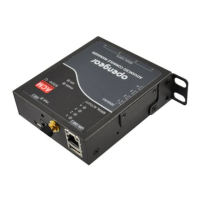Console Server & Router User Manual 325
A machine that provides a route (or pathway) to the outside world.
A network device that allows more than one computer to be connected as a LAN, usually using UTP cabling.
A worldwide system of computer networks - a public, cooperative, and self-sustaining network of networks accessible to
hundreds of millions of people worldwide. The Internet is technically distinguished because it uses the TCP/IP set of
protocols.
A private TCP/IP network within an enterprise.
Intelligent Platform Management Interface (IPMI) is a set of common interfaces to a computer system which system
administrators can use to monitor system health and manage the system. The IPMI standard defines the protocols for
interfacing with a service processor embedded into a server platform.
The length of time before keys are renegotiated
The Lightweight Directory Access Protocol (LDAP) is based on the X.500 standard, but significantly simpler and more
readily adapted to meet custom needs. The core LDAP specifications are all defined in RFCs. LDAP is a protocol used
to access information stored in an LDAP server.
Every piece of Ethernet hardware has a unique number assigned to it called it's MAC address. Ethernet is used locally
to connect the console server to the Internet, and it may share the local network with many other appliances. The MAC
address is used by the local Internet router in order to direct console server traffic to it rather than somebody else in the
local area. It is a 48-bit number usually written as a series of 6 hexadecimal octets, e.g. 00:d0:cf:00:5b:da. A console
server has a MAC address listed on a label underneath the device.
Microsoft Challenge Handshake Authentication Protocol (MSCHAP) is authentication for PPP connections between a
computer using a Microsoft Windows operating system and a network access server. It is more secure than PAP or
CHAP, and is the only option that also supports data encryption.
Network Address Translation. The translation of an IP address used on one network to an IP address on another
network. Masquerading is one particular form of NAT.
The way that computers know which part of a TCP/IP address refers to the network, and which part refers to the host
range.
Network File System is a protocol that allows file sharing across a network. Users can view, store, and update files on a
remote computer.
Network Time Protocol (NTP) used to synchronize clock times in a network of computers
Out-of-Band (OoB) management is any management done over channels and interfaces that are separate from those
used for user/customer data. Examples would include a serial console interface or a network interface connected to a
dedicated management network that is not used to carry customer traffic, or to a BMC/service processor. Any
management done over the same channels and interfaces used for user/customer data is In Band.
Password Authentication Protocol (PAP) is the usual method of user authentication used on the internet: sending a
username and password to a server where they are compared with a table of authorized users. Whilst most common,
PAP is the least secure of the authentication options.

